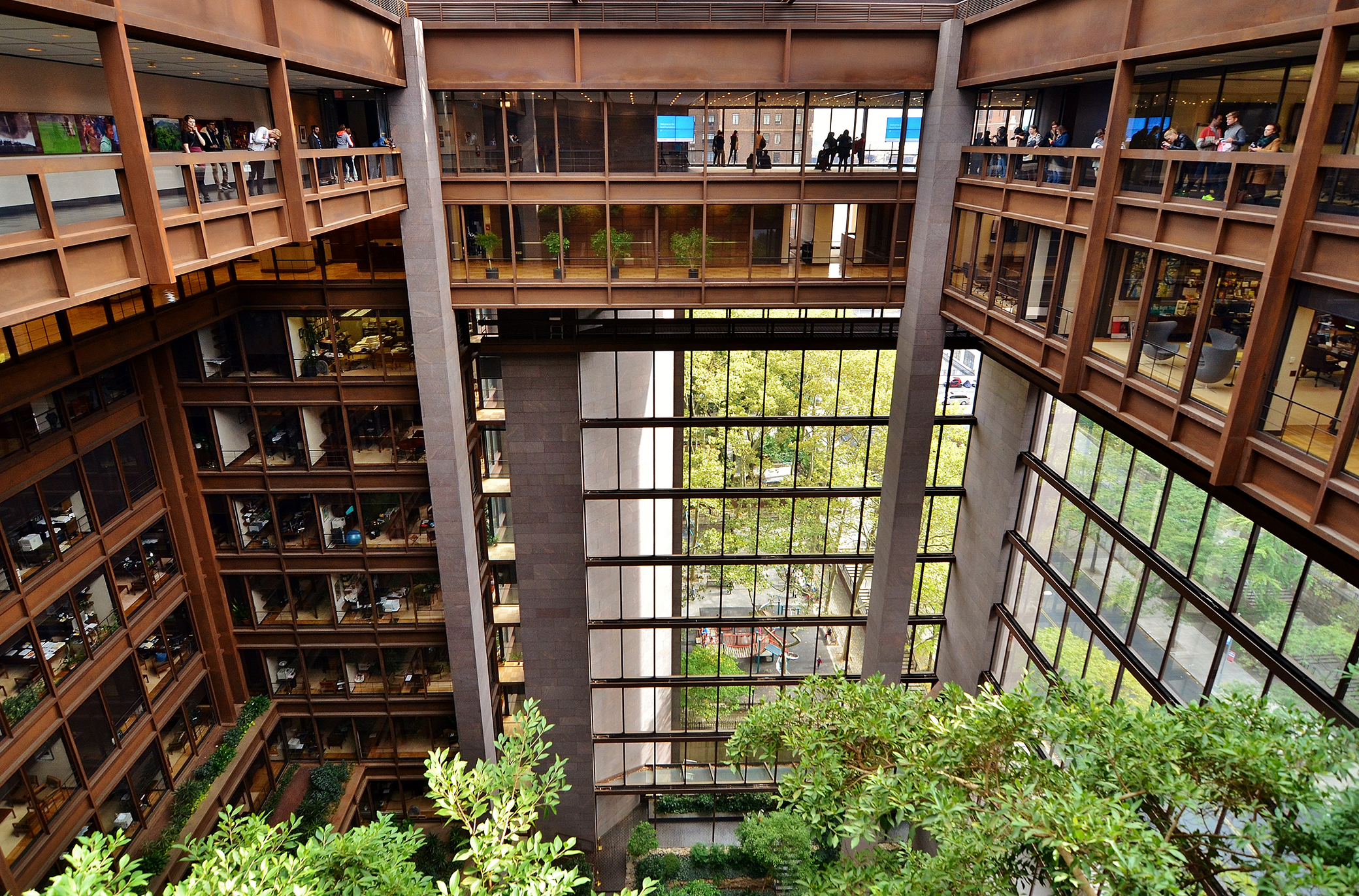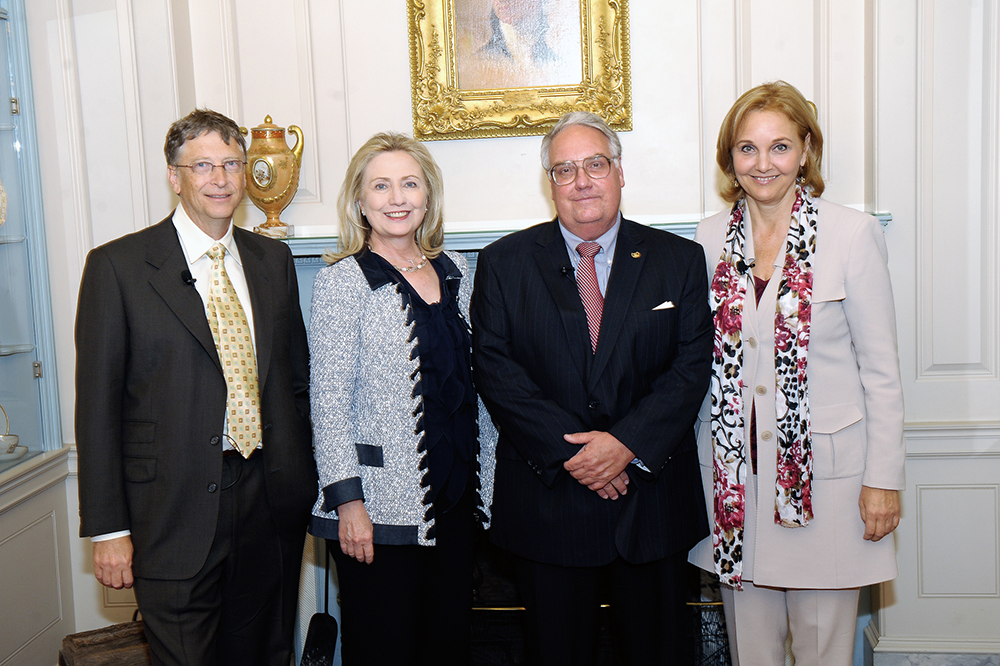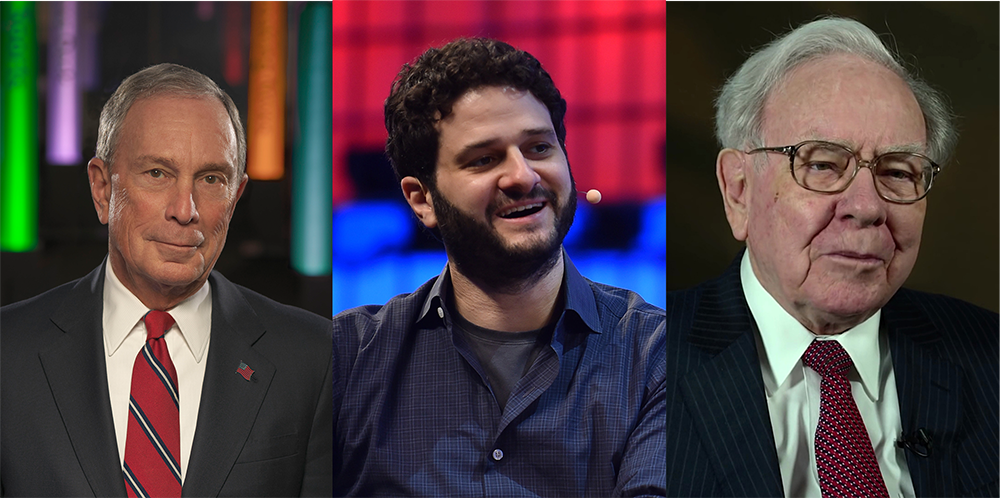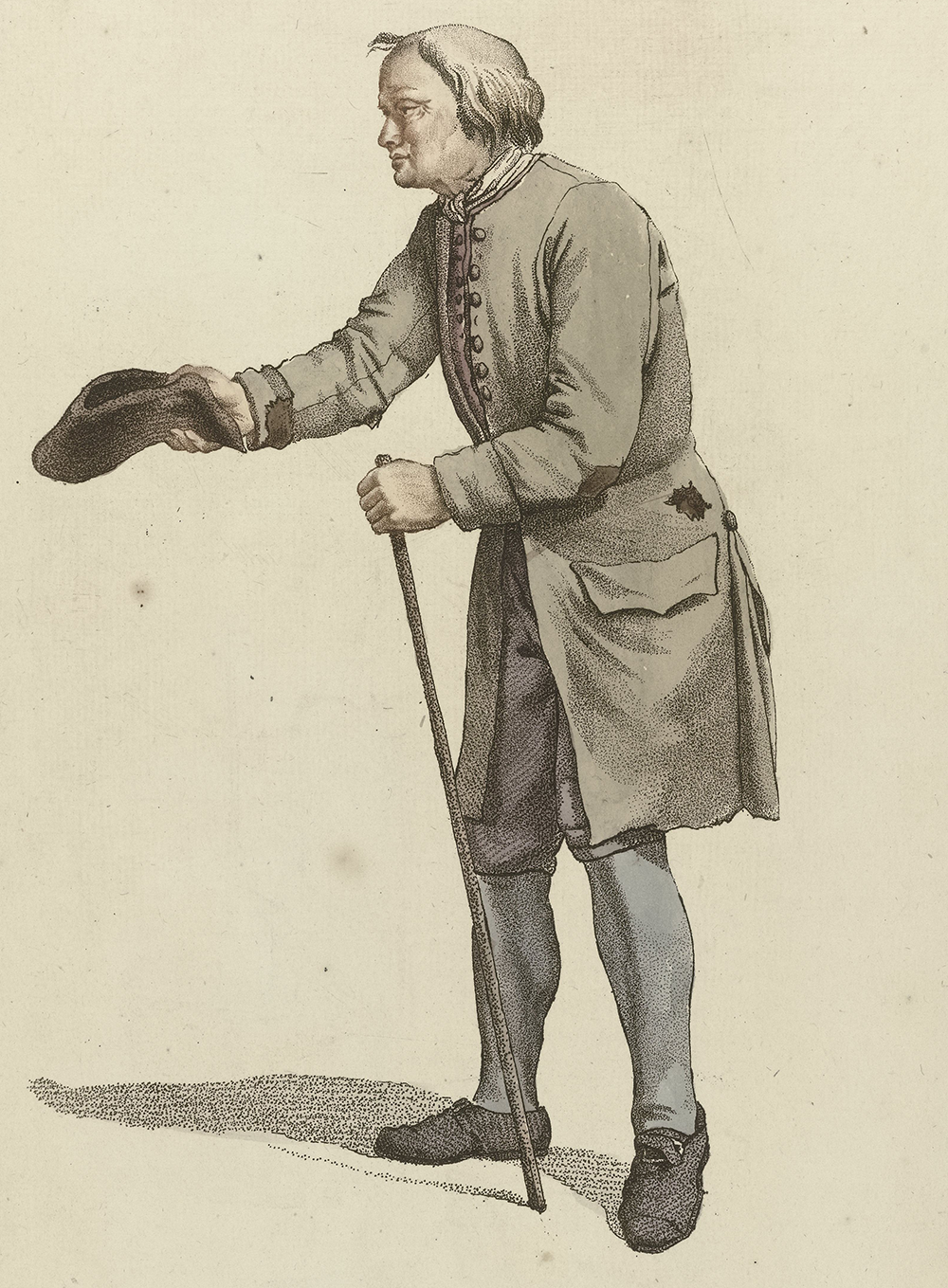
Inside the Ford Foundation Building in midtown Manhattan, 2015. Photograph by Gigi Altarejos.
In 2006 I chronicled an ugly clash between the Ford Foundation and leading pro-Israel organizations, which had accused Ford of funding Palestinian NGOs guilty of anti-Semitic behavior. It was a ferocious attack on a leading foundation, and it succeeded. Ford’s critics, with assistance from the Wall Street Journal and the New York Sun, forced it to rewrite its standard grant-agreement letter. This prompted a furious reply from the ACLU, the Drug Policy Alliance, and provosts at leading universities, all of whom argued that the new language was vague and potentially injurious to all of Ford’s grantees. But the ACLU and their allies possessed little leverage, while Ford had a pistol to its head. The problematic language remains in the letter to this day.
It was my first article about a major foundation, and the learning curve was steep. I knew little about the rules and habits of the nonprofit world, and I had few road maps to guide me. As I proceeded with my reporting, the questions kept piling up: Why was it so difficult to locate books and articles about the Ford Foundation? Why was Ford’s annual “payout”—the money it gives to grantees—so small, just 5 percent of its endowment? Why did the foundation yield so quickly when confronted by right-wing editorialists, pro-Israel muckrakers, and members of Congress? Why did nearly all my sources insist on speaking off the record? Finally, why was Ford itself so secretive? Its communications officer rebuffed me, and its then president, Susan Berresford, initially declined to be interviewed. I kept pressing her for a conversation, and finally Berresford agreed, but on her terms: it would be by telephone, and it would be short—ten minutes.
What I needed in 2006 to guide me was a book like David Callahan’s The Givers: Wealth, Power, and Philanthropy in a New Gilded Age, which is really two books in one. The first examines a constellation of new, superrich individuals in the U.S. who have deployed their immense wealth for public purposes in the realms of politics, ideas, infrastructure, digital technology, and science. Callahan has interviewed many of these donors, which gives his treatise an impressive journalistic texture. The second book is an astringent overview of the nonprofit world itself, what he calls “one of the last major sectors of U.S. society that gets to basically do as it pleases.” Callahan gives us an X-ray of a field that constitutes over 5 percent of GDP and 10 percent of private-sector employment but whose influence is barely registered by journalists and the public. (Only one major American newspaper, the Washington Post, has a full-time philanthropy reporter, Vanessa Small, and her beat is limited to the D.C. region.)
Callahan is a skillful guide through this topography: trained as a political scientist at Princeton, he sidestepped the tenure track and instead made himself at home in the world of foundations—not as a bureaucrat or dispassionate administrator but as an old-fashioned, left-liberal intellectual focused on politics, power, and privilege in American society.
In a 1999 report, Callahan revealed that conservative donors had, over a decade, quietly transferred $1 billion to twenty right-wing think tanks; he contrasted that triumph with liberalism’s dismal failure to develop a similar network of battle-ready institutions. Later, he cofounded the progressive think tank Demos. Along the way, Callahan, fifty-two, wrote half a dozen books on ethics, power, and U.S. foreign policy. In 2014 he established a California-based website, Inside Philanthropy, which produces edgy reportage on a modest budget. (One recent piece was titled “The Dark Side of Philanthropy: A Look at Tax-Exempt Donations to White Supremacists.”) He is not a stylish or graceful writer, but he is an effective and insightful one, and The Givers ought to ignite debate and discussion inside and outside the philanthropic sector for years to come.
Reading his account, one is struck, yet again, by the staggering amount of disposable wealth in the U.S., resting in relatively few hands. Seventy thousand individuals have assets of $30 million or more, and five thousand households have assets of over $100 million. The superwealthy have a choice: they can allow the IRS to tax their money at 40 percent, or they can dispose of their fortunes via philanthropy. Consequently, in the past fifteen years, thirty thousand new private foundations have been established. There are now more than ninety thousand private foundations, whose assets total $700 billion. These foundations supply money to more than a million tax-exempt, nonprofit organizations. Some of these nonprofits are financially secure, but many chafe under immense anxiety as they await annual grants from their masters in the foundation suites. (Other nonprofit groups derive their income from government and from fees for service.)
A significant number of superwealthy Americans have chosen to hoard their wealth. In 2010 Bill Gates and Warren Buffett began to urge their peers to use their money to advance the public good instead. Out of this effort emerged the “Giving Pledge,” in which participants (billionaires only, please) agree to eventually give away at least half of their fortunes during their lifetimes.

Since then, the Giving Pledge has received occasional bursts of publicity, but Callahan takes the time to remind us how much money is at stake in the Gates-Buffett initiative. “The U.S. billionaires who’ve signed the Giving Pledge,” he writes, “have almost as much money as the combined assets of all the U.S. foundations that now exist.” He continues with the eye-opening detail that “the joint net worth of just Gates and Buffett alone is greater than the assets of the top twenty-five U.S. foundations (excluding Gates’s own foundation).” To disburse fortunes of that size, he reminds us, one must strategize quite carefully: “When you have billions of dollars there’s no way you can dispose of more than a tiny fraction of it through even the most feverish personal excess.”
Consider the case of Michael Bloomberg, who is worth $48 billion and a signatory of the Giving Pledge. In recent years, Bloomberg has used his money not only to combat climate change and overfishing but also to prevent accidental drowning and traffic deaths in developing countries; he has given immense sums to hospitals and medical centers as well. Yet Callahan charges him with sluggishness. “The problem,” Callahan writes, “is that he’s not yet giving nearly enough. For all his big gifts in the past few years, he’ll need to get money out the door at a much faster rate to ever fulfill his Giving Pledge.”
This passage is typical of Callahan. He strives for a balanced, restrained tone, but the critic in him won’t hold his tongue. His method, by and large, is to examine those individuals who have agreed to the Giving Pledge, many of whom earned their fortunes in Silicon Valley and in finance. About these people he has no illusions. Executives of Google and Facebook “have both engaged in elaborate tax avoidance schemes using offshore subsidiaries,” and those enriched by hedge funds and private equity reaped the benefits of historically low tax rates on capital gains for the past two decades. We are reminded that “the financial world also played a leading role in crashing the U.S. economy in 2008.” In the narrow milieu of philanthropy journalism, writing like this stands out for its clarity.
But The Givers is not a screed; those looking for a rhetorical demolition of the superrich will be disappointed. “A simple narrative about plutocratic power,” Callahan insists at the start, “is the wrong way to understand big philanthropy.” In these pages, we encounter people who scooped up vast fortunes on Wall Street and whose opinions mirror those of the Wall Street Journal’s editorial page but who also deliver sizable checks to the ACLU, Human Rights Watch, the Innocence Project, and similar organizations. If one looks closely at philanthropists from the finance sector, Callahan points out, “you’ll find that few of them, as individuals, had much to do with the meltdown of 2008 and many would be fine with paying higher taxes.”
Callahan weaves into a broad history brief but incisive portraits of philanthropic luminaries Bill and Melinda Gates, George Soros, Warren Buffett, Eli Broad, Bloomberg, and several others. (The Koch brothers are mostly absent from his account, perhaps because Jane Mayer chronicled them so deftly in Dark Money.) But mainly Callahan examines lesser known figures, including in a revealing chapter on the children of the superrich. Warren Buffett’s son Howard controls a foundation that will spend $8 billion by 2045 and has worked tirelessly to build hydroelectric plants in the eastern Congo.

Although The Givers is not a crude narrative of elite domination, old-fashioned plutocrats do appear in its pages. Among them is Pete Peterson, the cofounder of the Blackstone Group, who was Nixon’s commerce secretary and the CEO of Lehman Brothers. His net worth? About $1.6 billion. Peterson, who died on March 20, had a long-standing interest in foreign policy—he was a major funder of the Council on Foreign Relations and its journal Foreign Affairs—but he was also zealous about deficit reduction. Callahan explains that the Peter G. Peterson Foundation began to exploit public fears about deficits after 2008, a time when many economists insisted that large-scale government spending was required to combat the effects of the recent financial crash. Peterson’s foundation spent millions financing deficit watchdog groups, dishing out money to like-minded think tanks, and even paying the salary of a top staffer on the Washington-based National Commission on Fiscal Responsibility and Reform, the bipartisan panel created by President Obama in 2010 and co-chaired by Alan Simpson and Erskine Bowles.
But events overtook Peterson. In 2011 and 2012 congressional Republicans seized the deficit issue, and mandatory across-the-board spending cuts were imposed. Callahan writes, “As the ax fell everywhere, including on vital areas like scientific research, Simpson and Bowles called the forced cuts ‘mindless.’” He adds, “Peterson wasn’t pleased with the outcome either…but he vowed to push on with his funding on deficits and debt.”
Other givers profiled by Callahan do not fit into neat ideological categories. Consider Enron veteran John Arnold, who was born in 1974. After college, he was hired by the Houston-based company and flourished there: in 2001, the year Enron collapsed, Arnold took home a bonus of $8 million. With that money, he created his own energy hedge fund, which soared, making him the United States’ youngest billionaire in 2007.
Arnold embodies what Callahan sees as a new breed of philanthropist—he is relatively young, oriented toward data, enamored of risk, and dismissive of an older, incremental giving model embodied by the Ford and Rockefeller Foundations. In their quest for social change, givers like Arnold are reluctant to support “causes”; they want to “solve problems—big ones,” as Callahan puts it. But, in Arnold’s case, lessons had to be learned along the way. His early forays into philanthropy, including an effort to reform public pensions, were scorned, with critics noting that Enron’s collapse had resulted in the loss of billions of dollars in pension funds.
But Callahan shows that Arnold has conscientiously striven to challenge his own assumptions about philanthropy and social change. Over time, and after various stops and starts, he began to focus his energy on criminal justice reform, making large grants to the Urban Institute and the Innocence Project. Currently, Arnold is funding innovative, data-oriented initiatives aimed at improving the pretrial and bail process, which Callahan says have been successful in a number of jurisdictions. The Arnold Foundation has also pushed to get police officers to wear body cameras. Callahan is intrigued by Arnold’s trajectory and sees him as a work in progress.
Callahan appreciates givers who display a certain amount of humility. Dustin Moskovitz, a cofounder of Facebook, is now worth $10 billion. But he is discomfited by his fortune, saying that he doesn’t think of it as “his” money but “the” money, which “belongs to the world.” Moskovitz and his wife, Cari Tuna (a former Wall Street Journal reporter), initially made small grants to the Schistosomiasis Control Initiative, which focuses on deworming in developing countries, and the Against Malaria Foundation.

Like Arnold, though, Moskovitz and Tuna weren’t keen to embrace traditional development organizations, which they are inclined to view as lethargic and bureaucratic. For them, grant making is akin to venture-capital investing: they want to act decisively and disrupt traditional models and structures. They have contributed $32 million to a group called Give Directly, which is not interested in vaccinating children, digging wells, building toilets, and creating schools. Rather, it gives cash handouts to the poor, who are free to spend the money as they wish. Callahan is skeptical of the ideology guiding Moskovitz and Tuna—who favor Silicon Valley mantras such as “empower individuals over institutions”—but he knows they are too influential to ignore. The couple will give away hundreds of millions of dollars every year. They are not yet thirty-five years old.
What are the political implications of the new philanthropy? There are growing concerns about the influence and reach of the superwealthy: “Philanthropy is becoming a much stronger power center,” Callahan says, “and, in some areas, is set to surpass government in its ability to shape society’s agenda.” The state has retreated; the givers have advanced.
Indeed, in many U.S. cities, elected officials are overwhelmed by debt obligations, and as a result have precious little money to spend on parks, museums, and other public services. The givers have no such constraints. In Boston, the Barr Foundation has done much to shape the city’s arts, culture, and political milieu. In Houston, Richard Kinder is helping to forge a massive network of urban trails. In Detroit, the Kresge Foundation is contributing funds for a new light-rail system. In New York, the Leon Levy Foundation has helped to revitalize a pair of Brooklyn landmarks, the Brooklyn Public Library and the Brooklyn Botanic Garden. These are worthy endeavors, but Callahan is right to express concern about a fundamental shift of power from a “hollowed-out public sector” to elite private givers who are not fully accountable and operate in dark corners. In 2008 Stephen A. Schwarzman, another cofounder of Blackstone, gave $100 million to the New York Public Library at a moment when the Library was secretly undertaking a dubious real estate and construction scheme. For nearly a decade, the NYPL refused to reveal how Schwarzman’s money was being utilized. Only in recent months did the Library account for the gift’s use: the $100 million formed part of the endowment and will soon be used for new renovation projects.
To a significant degree, the superwealthy have used their checkbooks to influence the political realm. Callahan found that Eli Broad has “pulled multiple levers of power”—and spent millions of dollars—in Los Angeles to create a climate in which charter schools can flourish. Under an initiative backed by Broad and like-minded funders, L.A. could add hundreds of new charter schools in a decade. Broad is quick to refute allegations that he is overreaching: “I think everyone is getting heard,” he informed Callahan. “We’re getting heard, the philanthropists. The unions and administrators are getting heard. Overall, we’re creating debate.”
That may be so, but increasingly the debate is among people who already agree. The Givers makes a persuasive case that the superwealthy are expanding their influence at a moment when many Americans are bolting from civic and political life. The author, drawing on the scholarship of Theda Skocpol, evokes an earlier era when mass-membership organizations such as trade unions flourished, giving ordinary citizens a certain degree of influence vis-à-vis elite power structures. These days, he writes, “We’re fast moving toward a future where private funders, not elected officials and the citizens they answer to, choreograph more of public life.”
The Givers is not just a portrait of the gilded ranks of the new philanthropists. Callahan also spotlights the privileges, quirks, contradictions, and absurdities of the foundation sector, where he has spent his career. The blade goes in deep, and one gets the feeling he has waited a long time to twist it.
The Givers is superb on the secrecy that defines the philanthropic world. Of the top eighty American foundations, only twenty-six post detailed information about their current grant making on public databases. The Susan Thompson Buffett Foundation, endowed by Warren’s wealth, “has no real website and the information available on its grant making through tax returns is always a few years out of date,” Callahan notes. The colossal fortunes of Mark Zuckerberg and Laurene Powell Jobs are being disbursed not via foundations but through their own limited liability corporations, which are hardly transparent.
Callahan reports that staff members at the top ten foundations are paid $600 million annually. The president of John Arnold’s foundation is paid nearly $700,000. “That level of pay is common for the head of a midsize foundation,” Callahan dryly observes, “and arguably quite generous for running an entity with no real bottom line, no competition, and no fear of ever going bankrupt.”
The Givers is alive to these and other contradictions in the philanthropic sector and poses thorny questions for elected officials and nonprofit leaders: why is a check to a right-wing think tank tax-deductible but a check to a conservative senator is not? Why are many large foundations spending a mere 5 percent of their assets each year when they can easily afford to spend more? Why do so many foundations exist in perpetuity, instead of “spending down” and closing their doors? Why is the sector so lightly regulated by government, particularly the IRS? Finally, what exactly is the public getting in exchange for colossal tax breaks granted for philanthropy, which mainly go to rich people?

For Callahan, the philanthropic world is an obvious target for reform, but its leaders are smug and listless—the very qualities exhibited by their predecessors in 1969, when members of the House Ways and Means Committee excoriated McGeorge Bundy, then the president of the Ford Foundation. In the wake of those hearings, Congress enacted regulatory legislation that impacted all foundations. For decades memories of the 1969 hearings shaped the thinking of not only Ford’s leadership but other foundation presidents as well. The Givers, which went to press before Donald Trump was elected, concludes with a stark and prescient warning: the nonprofit sector should initiate its own reforms, before politicians do it with a heavier and more mischievous hand. “It’s not okay,” he warns, “to settle for a status quo in which the foundation world remains forever a black box.” His proposals for change—the creation of a new U.S. federal office of charitable affairs, a reevaluation of what should qualify for tax-exempt status, trustee boards that are more inclusive and transparent—are not likely to be embraced in Trump’s Washington, however.
The Givers has inspired a spirited discussion among philanthropy experts. Writing in the Chronicle of Philanthropy, Pablo Eisenberg, one of the nonprofit sector’s few gadflies, began his review by lamenting that Callahan’s book is “not very analytical, courageous in tone, or full of useful recommendations for change.” (Eisenberg declined to articulate what a more “courageous” tone might sound like.) But he concluded that Callahan nonetheless “has provided a notable public service.”
Princeton University historian Stanley Katz, on the HistPhil blog, praised the sophistication and readability of The Givers but argued that Callahan “tries too hard to be fair to individual philanthropists,” and that his critique of the superwealthy is tepid. The fact that James Simons, who is sympathetically featured in The Givers, was recently outed in the Paradise Papers for sheltering $8 billion in Bermuda, adds weight to Katz’s assessment.
Katz also detected inconsistencies in the author’s analytical framework. Callahan is acutely aware that plutocrats have done much to weaken the New Deal/Great Society political framework he cherishes, describing it as a “brilliant power grab: First, the wealthy helped knock out government. Now, they’re taking more direct charge of society themselves, using philanthropy as one tool.” But Callahan concludes that “the new big philanthropy is likely to be a net positive in its substantive effects on U.S. society.” Katz, writing after Trump’s victory, argued that Callahan has sidestepped the central issue:
Our current dire political situation is the product of both traditional American anti-statism and a very different and deliberate assault on the state by plutocrats. We do not have so many billionaires, and thus mega-foundations, because we now have a larger and more adept entrepreneurial class, but because the structure of (mostly federal) economic policy has been captured by people of wealth, who have rewritten the laws to enable themselves to become extraordinarily rich…It seems to me that the new plutocrats are in fact the problem, and they are quite unlikely to be part of the solution, as Callahan contends.
Let the debate unfold. My own wish is that Callahan had confronted, in a more pungent way, the structural features of the behemoth that looms before him: the grant-making model itself, upon which modern American philanthropy rests. Foundation leaders advocate transparency, inclusion, and equality, but they operate in a strikingly hierarchical manner. They are a cloistered elite.
Does this top-down model—in which grantees spend immense time and energy chasing cash—inhibit the growth of dues-paying organizations, which may be more vibrant and democratic than nonprofit organizations dominated by an aloof board of trustees and an executive director? Passages in The Givers suggest that Callahan has pondered these matters, but he stops short of a full critique. Hierarchy and hubris in the foundation suites: it would make a rousing series of articles for Inside Philanthropy.
Read more on the philanthropy debate in our Summer 2015 issue, Philanthropy.